Optimal Transient Control Scheme for Grid-Forming Permanent Magnet Synchronous Generator-Based Wind Farms
Abstract
1. Introduction
2. Proposed Transient Control Scheme of the WF
2.1. Problem Description
2.2. Analysis of the Energy Flow Mechanism
2.3. Control Framework
3. Power Optimization for Wind Farms
3.1. Power Model of WF
3.2. Objective Function and Constraints of Wind Farm Control Level
4. Maximum Kinetic Energy Storage Control for the WTs
4.1. Maximum KES Model
4.2. Objective Function and Constraints of Wind Turbine Control Level
- (1)
- Objective 1: The primary goal is to regulate the DC bus voltage to maintain it within an acceptable range during the fault process. This can be expressed as follows:
- (2)
- Objective 2: The secondary goal is to regulate the d-axis current (also known as the weak magnetic current) of the RSC to maximize the KES capacity during the FRT and subsequent recovery process. This can be expressed as follows:
- (3)
- Objective 3: The third goal is to regulate the d-axis and q-axis currents of the Grid Side Converter (GSC) to adhere to the active and reactive power commands issued by the upper-level controller. This can be expressed as follows:
5. Case Study
5.1. Simulation Models
5.2. Control Performance with the Proposed Control and the Traditional Control Scheme
5.3. Control Performance Under Different Wind Speed Conditions
6. Conclusions
Author Contributions
Funding
Institutional Review Board Statement
Informed Consent Statement
Data Availability Statement
Conflicts of Interest
References
- Gul, W.; Gao, Q.; Lenwari, W. Optimal Design of a 5-MW Double-Stator Single-Rotor PMSG for Offshore Direct Drive Wind Turbines. IEEE Trans. Ind. Appl. 2020, 56, 216–225. [Google Scholar] [CrossRef]
- Singh, B.; Niwas, R. Power Quality Improvement of PMSG-Based DG Set Feeding Three-Phase Loads. IEEE Trans. Ind. Appl. 2016, 52, 466–471. [Google Scholar] [CrossRef]
- Zeng, L.; Li, C.; Li, Z.; Shahidehpour, M.; Zhou, B.; Zhou, Q. Hierarchical Bipartite Graph Matching Method for Transactive V2V Power Exchange in Distribution Power System. IEEE Trans. Smart Grid 2020, 12, 301–311. [Google Scholar] [CrossRef]
- Huang, S.; Wu, Q.; Liao, W.; Wu, G.; Li, X.; Wei, J. Adaptive Droop-Based Hierarchical Optimal Voltage Control Scheme for VSC-HVdc Connected Offshore Wind Farm. IEEE Trans. Ind. Inform. 2021, 17, 8165–8176. [Google Scholar] [CrossRef]
- Li, W.; Zhu, M.; Chao, P.; Liang, X.; Xu, D. Enhanced FRT and Postfault Recovery Control for MMC-HVDC Connected Offshore Wind Farms. IEEE Trans. Power Syst. 2020, 35, 1606–1617. [Google Scholar] [CrossRef]
- Xu, D.; Wu, Q.; Zhou, B.; Li, C.; Bai, L.; Huang, S. Distributed Multi-Energy Operation of Coupled Electricity, Heating, and Natural Gas Networks. IEEE Trans. Sustain. Energy 2020, 11, 2457–2469. [Google Scholar] [CrossRef]
- Huang, S.; Wu, Q.; Guo, Y.; Chen, X.; Zhou, B.; Li, C. Distributed Voltage Control Based on ADMMfor Large-Scale Wind Farm Cluster Connected to, V.S.C.-H.V.D.C. IEEE Trans. Sustain. Energy 2020, 11, 584–594. [Google Scholar] [CrossRef]
- Ruan, J.-Y.; Lu, Z.-X.; Qiao, Y.; Min, Y. Analysis on Applicability Problems of the Aggregation-Based Representation of Wind Farms Considering DFIGs’ LVRT Behaviors. IEEE Trans. Power Syst. 2016, 31, 4953–4965. [Google Scholar] [CrossRef]
- Jin, R.; Hou, P.; Yang, G.; Qi, Y.; Chen, C.; Chen, Z. Cable routing optimization for offshore wind power plants via wind scenarios considering power loss cost model. Appl. Energy 2019, 254, 113719. [Google Scholar] [CrossRef]
- Shi, M.; Chen, X.; Zhou, J.; Chen, Y.; Wen, J.; He, H. Advanced Secondary Voltage Recovery Control for Multiple HESSs in a Droop-Controlled DC Microgrid. IEEE Trans. Smart Grid 2019, 10, 3828–3839. [Google Scholar] [CrossRef]
- Dash, P.; Patnaik, R.; Mishra, S. Adaptive fractional integral terminal sliding mode power control of UPFC in DFIG wind farm penetrated multimachine power system. Prot. Control Mod. Power Syst. 2018, 3, 8. [Google Scholar] [CrossRef]
- Raza, M.; Collados, C.; Gomis-Bellmunt, O. Reactive power management in an offshore AC network having multiple voltage source converters. Appl. Energy 2017, 265, 793–803. [Google Scholar] [CrossRef]
- Xiao, X.-Y.; Yang, R.-H.; Zheng, Z.-X.; Wang, Y. Cooperative Rotor-Side SMES and Transient Control for Improving the LVRT Capability of Grid-Connected DFIG-Based Wind Farm. IEEE Trans. Appl. Supercond. 2019, 29, 1–5. [Google Scholar] [CrossRef]
- Zou, Z.-C.; Liao, J.-C.; Lei, Y.; Mu, Z.-L.; Xiao, X.-Y. Postfault LVRT Performance Enhancement of DFIG Using a Stage-Controlled SSFCL-RSDR. IEEE Trans. Appl. Supercond. 2019, 29, 1–6. [Google Scholar] [CrossRef]
- Ren, J.; Xiao, X.; Zheng, Z.; Ma, Z. ASMES-Based Dynamic Current Limiter to Improve the LVRTCapability of DFIG-Based, W.E.C.S. IEEE Trans. Appl. Supercond. 2021, 31, 1–5. [Google Scholar]
- Guo, W.; Zhang, G.; Zhang, J.; Song, N.; Gao, Z.; Xu Xi Jing, L.; Teng, Y.; Zhu, Z.; Xiao, L. Development of a 1-MVA/1-MJ Superconducting Fault Current Limiter–Magnetic Energy Storage System for LVRT Capability Enhancement and Wind Power Smoothing. IEEE Trans. Appl. Supercond. 2018, 28, 1–5. [Google Scholar] [CrossRef]
- Alsmadi, Y.M.; Xu, L.; Blaabjerg, F.; Ortega, A.J.P.; Abdelaziz, A.Y.; Wang, A.; Albataineh, Z. Detailed Investigation and Performance Improvement of the Dynamic Behavior of Grid-Connected DFIG-Based Wind Turbines Under LVRT Conditions. IEEE Trans. Ind. Appl. 2018, 54, 4795–4812. [Google Scholar] [CrossRef]
- Zhou, H.; Yao, W.; Sun, K.; Zong, Q.; Zhao, H.; Wen, J. Enhancing Fault Ride-Through and Voltage Support Capability for MMC-HVDC Integrated Offshore Wind Farms Based on Multi-Mode Matching. IEEE Trans. Sustain. Energy 2024, 15, 1256–1268. [Google Scholar] [CrossRef]
- Jia, K.; Dong, X.; Wen, Z.; Wu, W.; Bi, T. Harmonic Injection Based Fault Ride-through Control of MMC-HVDC Connected Offshore Wind Farms. IEEE Trans. Sustain. Energy 2023, 14, 1796–1806. [Google Scholar] [CrossRef]
- Zhou, C.; Wang, Z.; Xin, H.; Ju, P. A PQ Coordination Based Model Predictive Control for DFIG High-Voltage Ride Through. IEEE Trans. Energy Convers. 2022, 37, 254–263. [Google Scholar] [CrossRef]
- Bao, W.; Wu, Q.; Ding, L.; Huang, S.; Terzija, V. A Hierarchical Inertial Control Scheme for Multiple Wind Farms with BESSs Based on ADMM. IEEE Trans. Sustain. Energy 2021, 12, 751–760. [Google Scholar] [CrossRef]
- Xiong, Y.; Yao, W.; Yao, Y.; Fang, J.; Ai, X.; Wen, J.; Cheng, S. Distributed Cooperative Control of Offshore Wind Farms Integrated via MTDC System for Fast Frequency Support. IEEE Trans. Ind. Electron. 2023, 70, 4693–4704. [Google Scholar] [CrossRef]
- Lyu, X.; Jia, Y.; Xu, Z. A Novel Control Strategy for Wind Farm Active Power Regulation Considering Wake Interaction. IEEE Trans. Sustain. Energy 2020, 11, 618–628. [Google Scholar] [CrossRef]
- Guo, Y.; Gao, H.; Wu, Q.; Zhao, H.; Ostergaard, J.; Shahidehpour, M. Enhanced voltage control ofVSC-HVDC-connected offshorewind farms based on model predictive control. IEEE Trans. Sustain. Energy 2018, 9, 474–487. [Google Scholar] [CrossRef]
- Li, Y.; Xu, Z.; Zhang, J.; Meng, K. Variable droop voltage control for wind farm. IEEE Trans. Sustain. Energy 2018, 9, 491–493. [Google Scholar] [CrossRef]
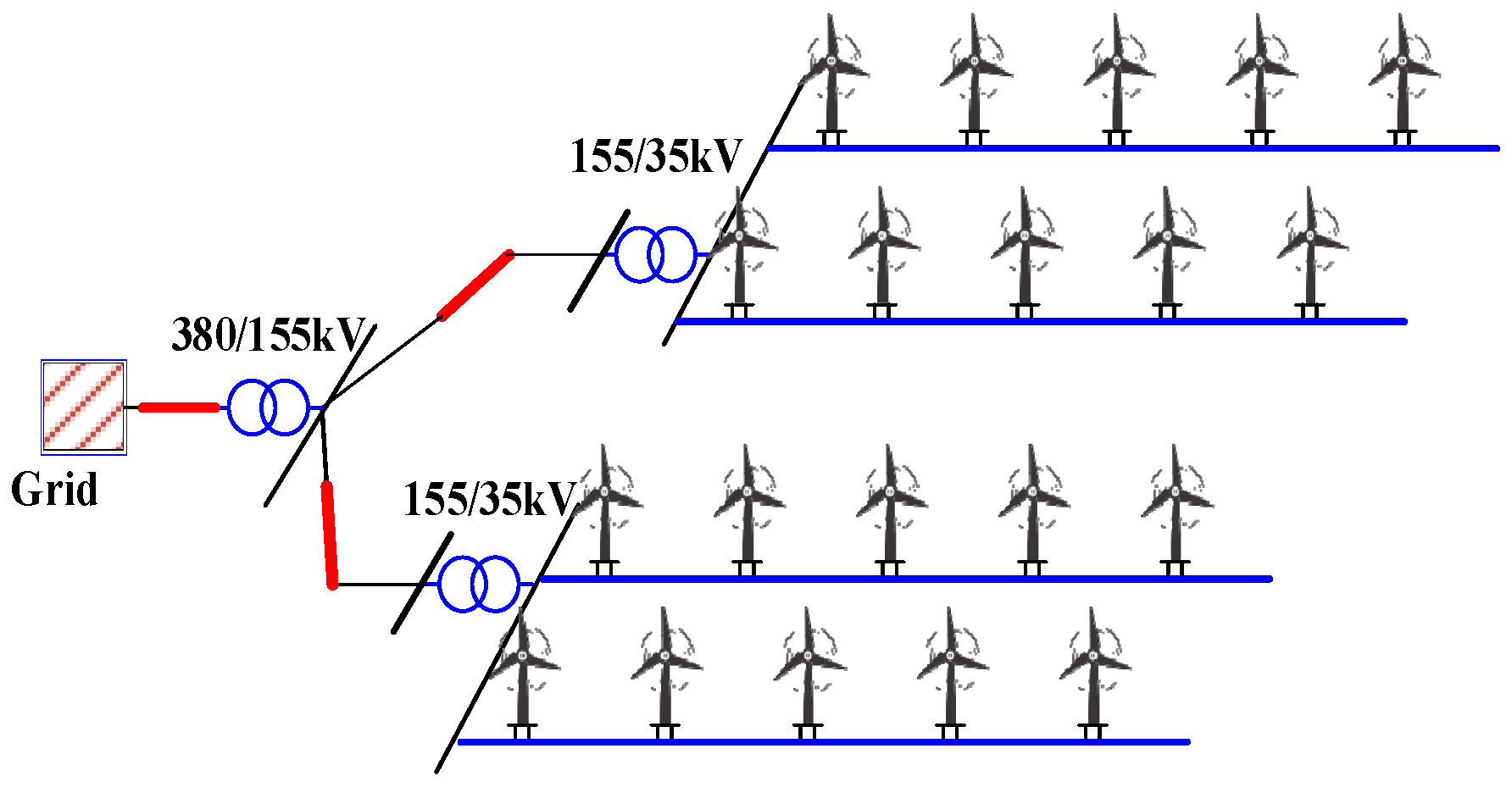
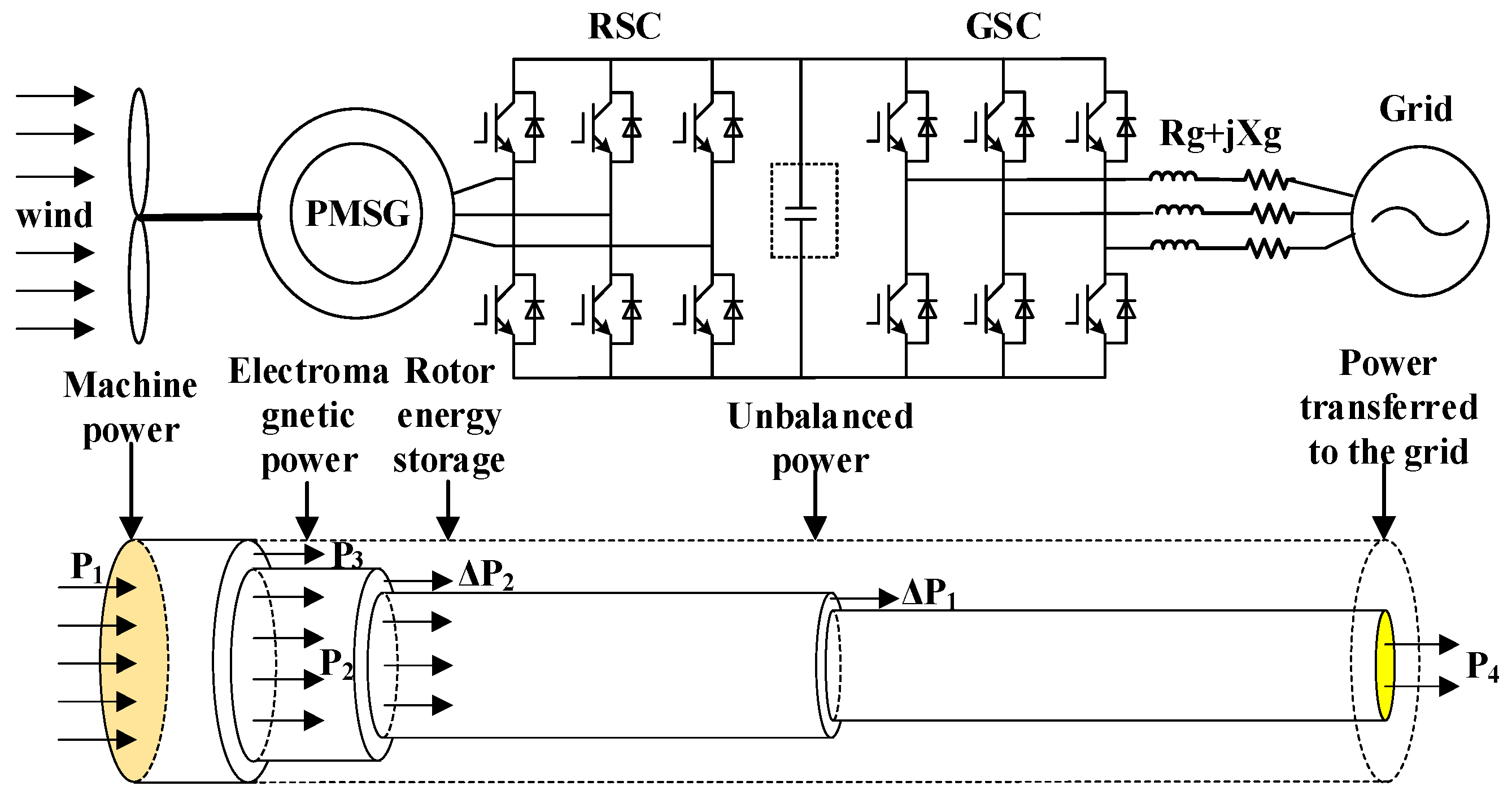
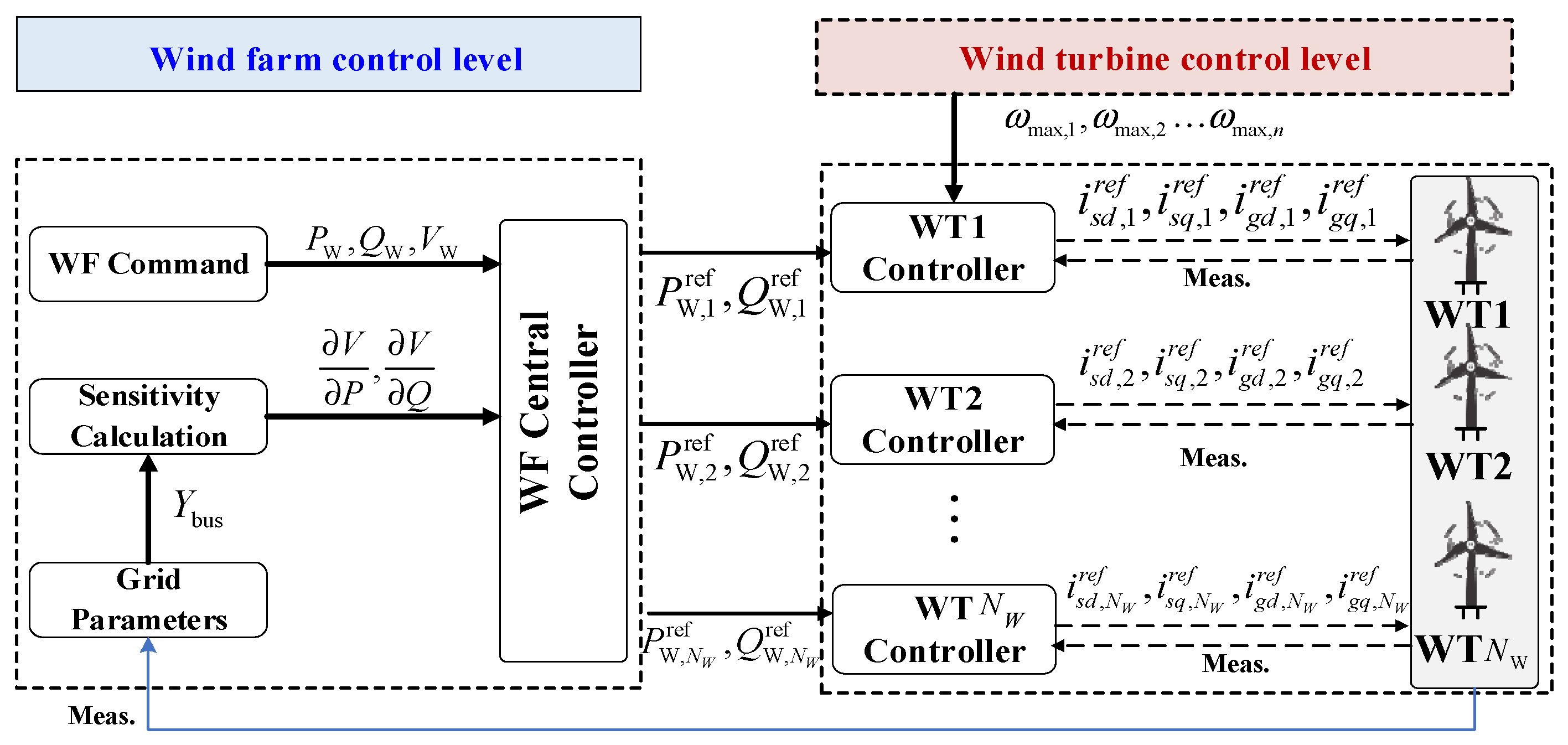
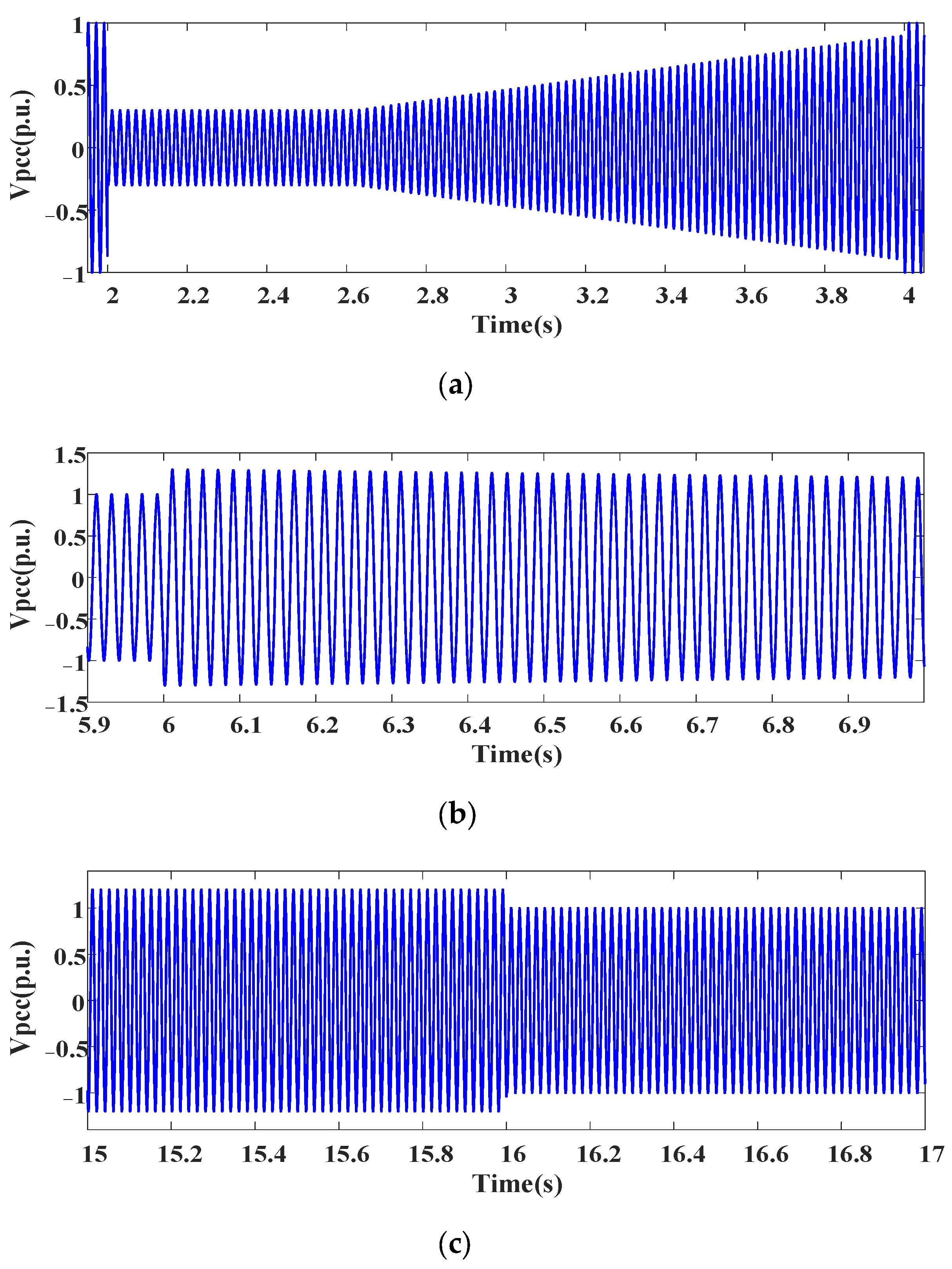

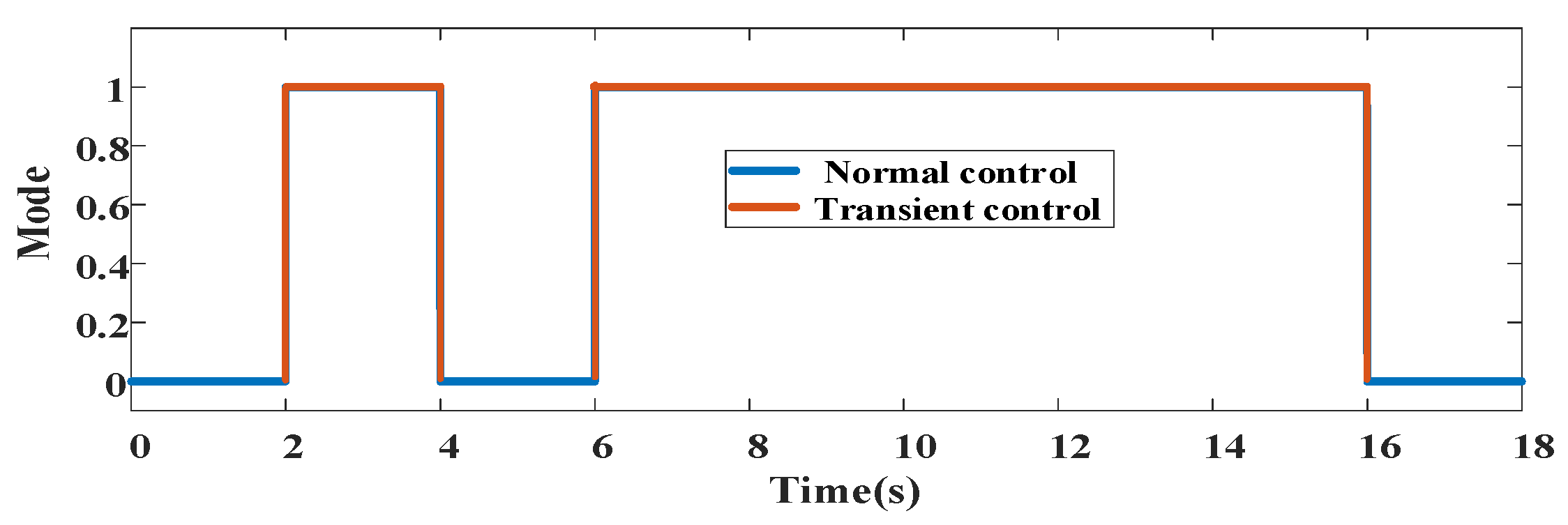
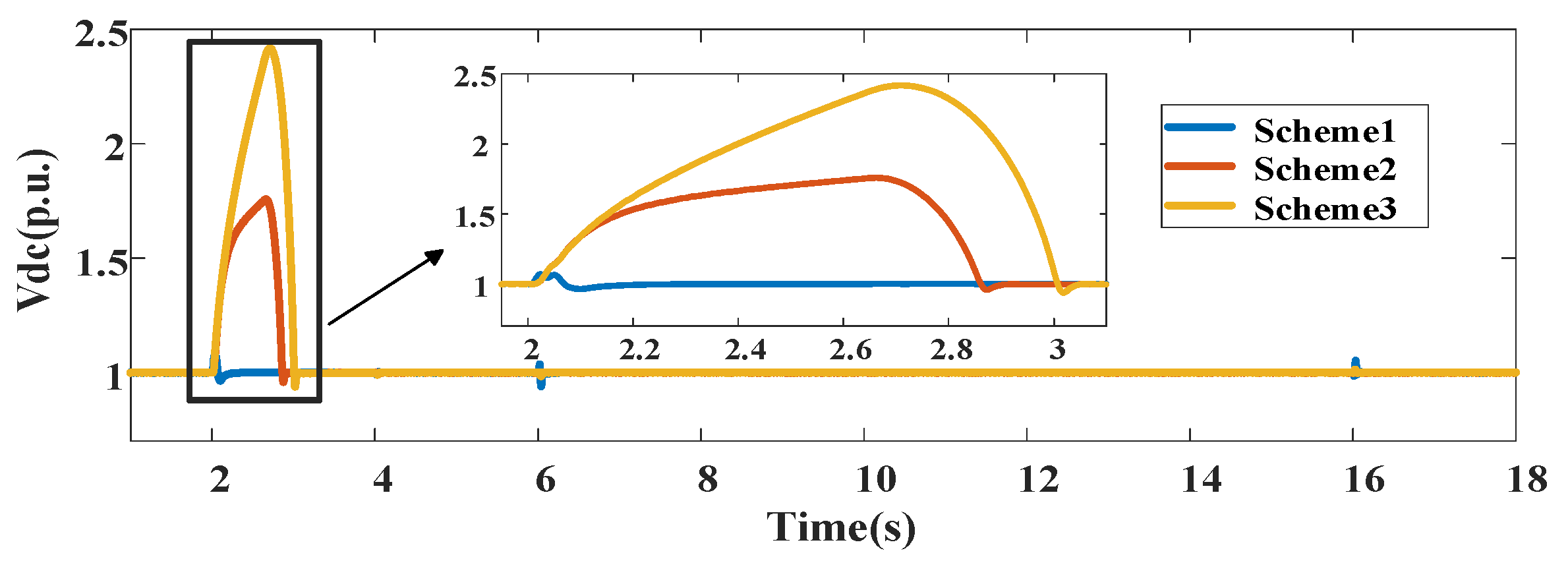
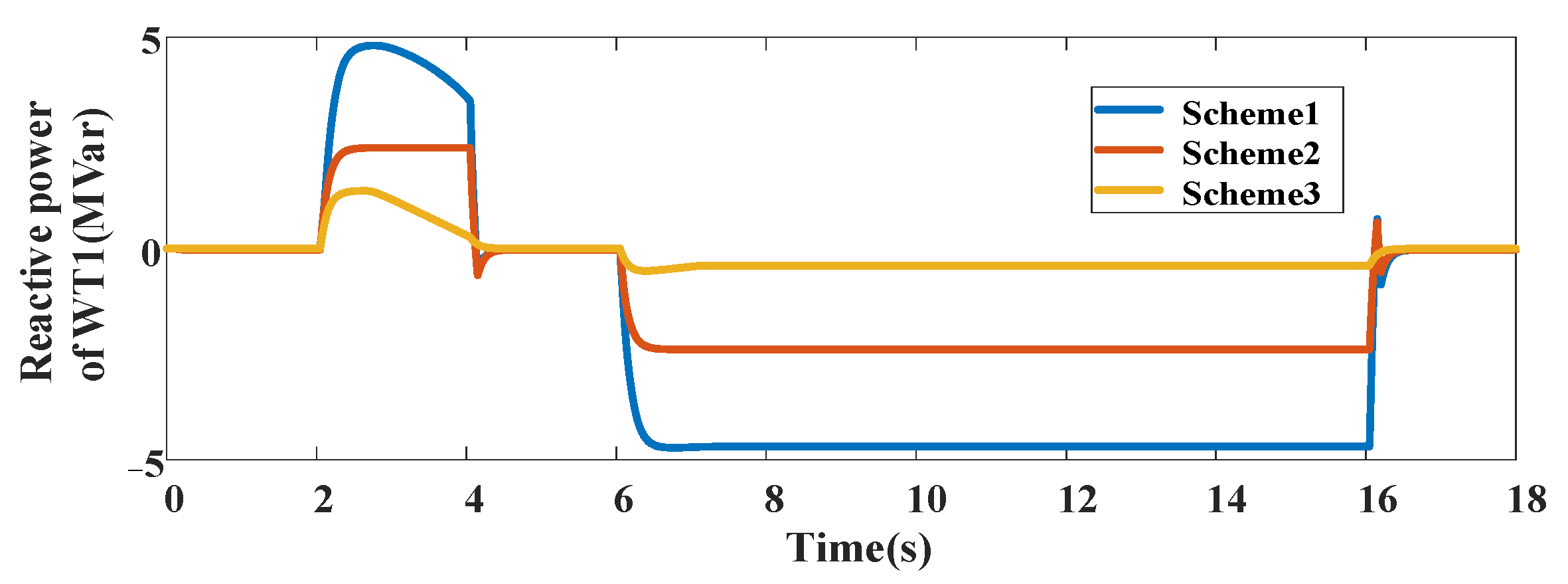


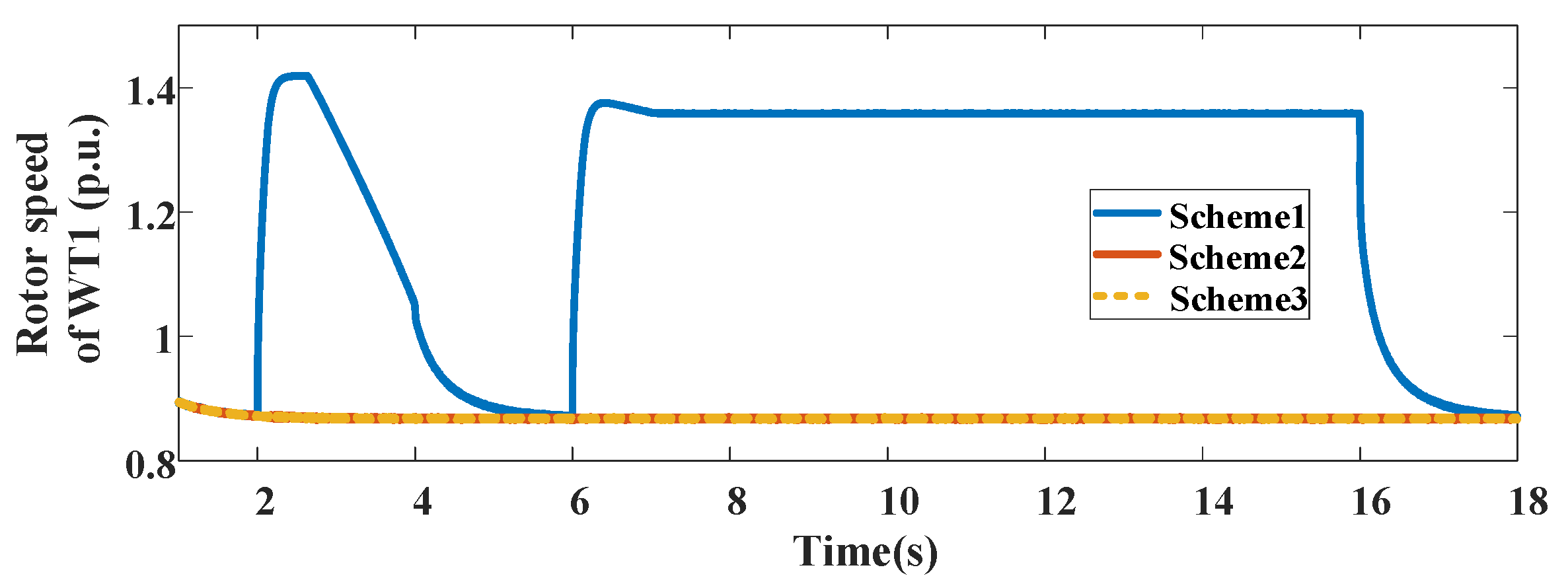
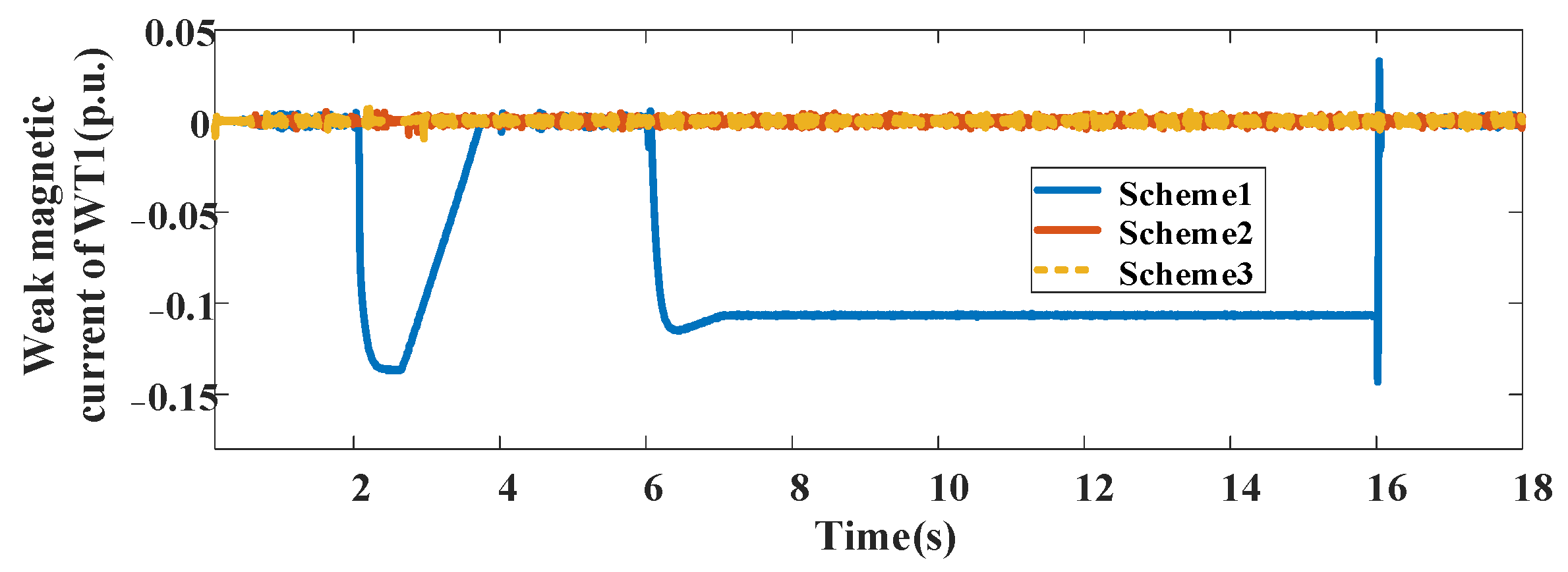
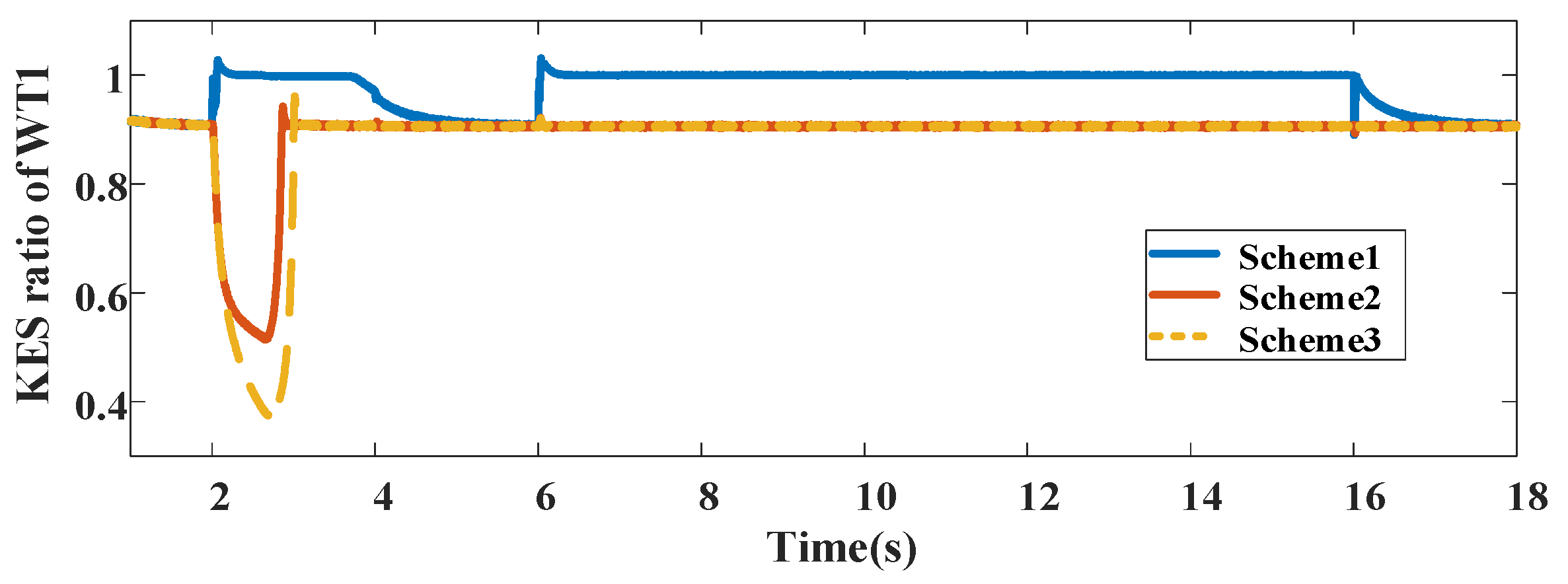



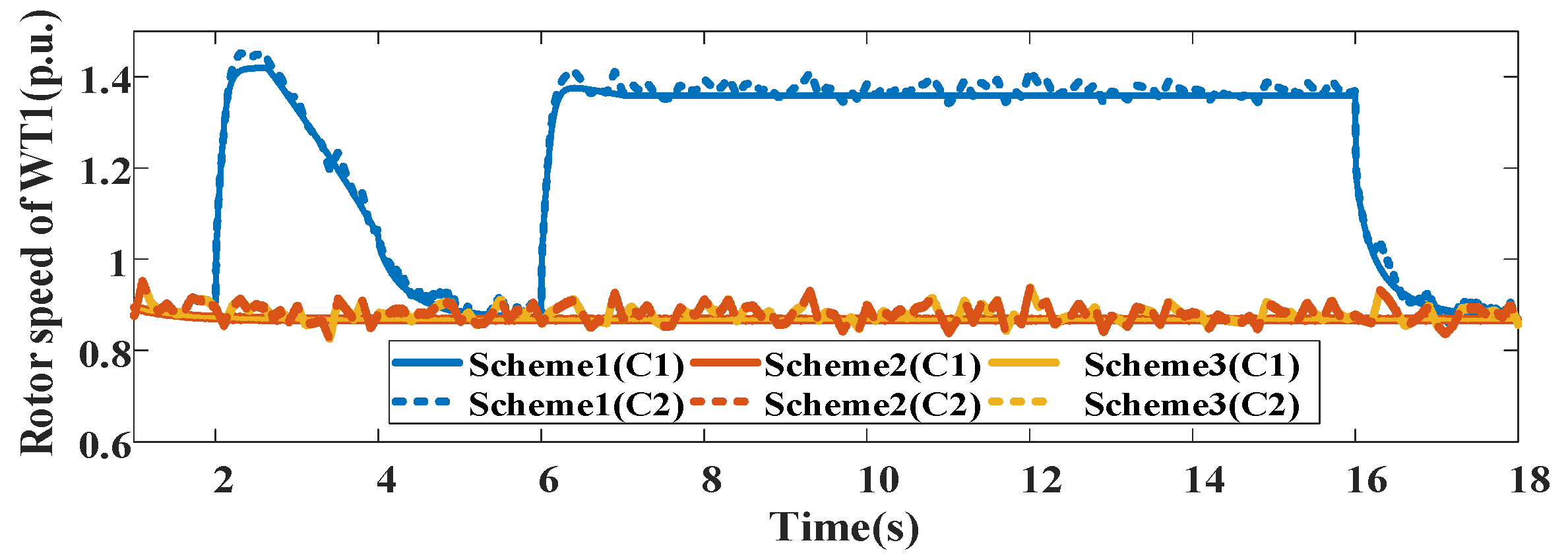
| Parameters | Value |
|---|---|
| Wind farm rated power | PWF = 100 MW |
| WT rated power | PWT = 5 MW |
| Stator resistance | R = 0.2 Ω |
| Cross-axis and straight-axis inductors | L = 0.00514 H |
| Rate frequency | f = 50 Hz |
| Rated power of WT | S = 5 MW |
| Vpcc (p.u.) | Scheme 1 (Proposed) | Scheme 2 | Scheme 3 | ||
|---|---|---|---|---|---|
| 0.3 | 0.351 | 0.330 | 6.36% | 0.312 | 12.50% |
| 1.2 | 1.183 | 1.195 | 1.00% | 1.201 | 1.50% |
| Vpcc (p.u.) | Scheme 1 (Proposed) | Scheme 2 | Scheme 3 | ||
|---|---|---|---|---|---|
| 0.3 | 1.425 | 0.864 | 64.93% | 0.864 | 64.93% |
| 1.2 | 1.375 | 0.864 | 59.14% | 0.864 | 59.14% |
Disclaimer/Publisher’s Note: The statements, opinions and data contained in all publications are solely those of the individual author(s) and contributor(s) and not of MDPI and/or the editor(s). MDPI and/or the editor(s) disclaim responsibility for any injury to people or property resulting from any ideas, methods, instructions or products referred to in the content. |
© 2025 by the authors. Licensee MDPI, Basel, Switzerland. This article is an open access article distributed under the terms and conditions of the Creative Commons Attribution (CC BY) license (https://creativecommons.org/licenses/by/4.0/).
Share and Cite
Hu, P.; Liu, D.; Cao, K.; Wei, L. Optimal Transient Control Scheme for Grid-Forming Permanent Magnet Synchronous Generator-Based Wind Farms. Technologies 2025, 13, 215. https://doi.org/10.3390/technologies13060215
Hu P, Liu D, Cao K, Wei L. Optimal Transient Control Scheme for Grid-Forming Permanent Magnet Synchronous Generator-Based Wind Farms. Technologies. 2025; 13(6):215. https://doi.org/10.3390/technologies13060215
Chicago/Turabian StyleHu, Pan, Dan Liu, Kan Cao, and Lai Wei. 2025. "Optimal Transient Control Scheme for Grid-Forming Permanent Magnet Synchronous Generator-Based Wind Farms" Technologies 13, no. 6: 215. https://doi.org/10.3390/technologies13060215
APA StyleHu, P., Liu, D., Cao, K., & Wei, L. (2025). Optimal Transient Control Scheme for Grid-Forming Permanent Magnet Synchronous Generator-Based Wind Farms. Technologies, 13(6), 215. https://doi.org/10.3390/technologies13060215






